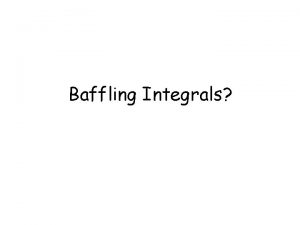5 Integrals Copyright Cengage Learning All rights reserved


























- Slides: 26

5 Integrals Copyright © Cengage Learning. All rights reserved.

5. 5 The Substitution Rule Copyright © Cengage Learning. All rights reserved.

The Substitution Rule Because of the Fundamental Theorem, it’s important to be able to find antiderivatives. But our antidifferentiation formulas don’t tell us how to evaluate integrals such as To find this integral we use the problem-solving strategy of introducing something extra. Here the “something extra” is a new variable; we change from the variable x to a new variable u. 3

The Substitution Rule Suppose that we let u be the quantity under the root sign in (1), u = 1 + x 2. Then the differential of u is du = 2 xdx. Notice that if the dx in the notation for an integral were to be interpreted as a differential, then the differential 2 xdx would occur in (1) and so, formally, without justifying our calculation, we could write 4

The Substitution Rule But now we can check that we have the correct answer by using the Chain Rule to differentiate the final function of Equation 2: In general, this method works whenever we have an integral that we can write in the form f (g (x)) g (x) dx. 5

The Substitution Rule Observe that if F = f, then F (g (x)) g (x) dx = F (g (x)) + C because, by the Chain Rule, [F (g (x))] = F (g (x)) g (x) If we make the “change of variable” or “substitution” u = g (x), then from Equation 3 we have F (g (x)) g (x) dx = F (g (x)) + C = F (u) du or, writing F = f, we get f (g (x)) g (x) dx = f (u) du 6

The Substitution Rule Thus we have proved the following rule. Notice that the Substitution Rule for integration was proved using the Chain Rule for differentiation. Notice also that if u = g (x), then du = g (x) dx, so a way to remember the Substitution Rule is to think of dx and du in (4) as differentials. 7

The Substitution Rule Thus the Substitution Rule says: It is permissible to operate with dx and du after integral signs as if they were differentials. 8

Example 1 Find x 3 cos(x 4 + 2) dx. Solution: We make the substitution u = x 4 + 2 because its differential is du = 4 x 3 dx, which, apart from the constant factor 4, occurs in the integral. Thus, using x 3 dx = du and the Substitution Rule, we have x 3 cos(x 4 + 2) dx = cos u = cos u du du 9

Example 1 – Solution = sin u + C = sin(x 4 + 2) + C cont’d Notice that at the final stage we had to return to the original variable x. 10

Example 2 11

Example 3 12

Example 4 13

Example 5 14

Example 6 15

Definite Integrals 16

Definite Integrals When evaluating a definite integral by substitution, two methods are possible. One method is to evaluate the indefinite integral first and then use the Fundamental Theorem. For example, 17

Definite Integrals Another method, which is usually preferable, is to change the limits of integration when the variable is changed. 18

Example 7 Evaluate using (6). Solution: Let u = 2 x + 1 and dx = du. To find the new limits of integration we note that when x = 0, u = 2(0) + 1 = 1 and when x = 4, u = 2(4) + 1 = 9 19

Example 7 – Solution cont’d Therefore Observe that when using (6) we do not return to the variable x after integrating. We simply evaluate the expression in u between the appropriate values of u. 20

Symmetry 21

Symmetry The following theorem uses the Substitution Rule for Definite Integrals (6) to simplify the calculation of integrals of functions that possess symmetry properties. 22

Symmetry Theorem 7 is illustrated by Figure 3 For the case where f is positive and even, part (a) says that the area under y = f (x) from –a to a is twice the area from 0 to a because of symmetry. 23

Symmetry We know that an integral can be expressed as the area above the x-axis and below y = f (x) minus the area below the axis and above the curve. Thus part (b) says the integral is 0 because the areas cancel. 24

Example 10 Since f (x) = x 6 + 1 satisfies f (–x) = f (x), it is even and so 25

Example 11 Since f (x) = (tan x)/(1 + x 2 + x 4) satisfies f (–x) = –f (x), it is odd and so 26
 Copyright 2015 all rights reserved
Copyright 2015 all rights reserved Copyright 2015 all rights reserved
Copyright 2015 all rights reserved Dell all rights reserved copyright 2009
Dell all rights reserved copyright 2009 Copyright © 2018 all rights reserved
Copyright © 2018 all rights reserved Cengage chapter 7
Cengage chapter 7 All rights reserved example
All rights reserved example All rights reserved sentence
All rights reserved sentence Creative commons vs all rights reserved
Creative commons vs all rights reserved Confidential all rights reserved
Confidential all rights reserved Sentinel-controlled loop pseudocode
Sentinel-controlled loop pseudocode 2012 pearson education inc
2012 pearson education inc Microsoft corporation. all rights reserved.
Microsoft corporation. all rights reserved. Microsoft corporation. all rights reserved
Microsoft corporation. all rights reserved Microsoft corporation. all rights reserved
Microsoft corporation. all rights reserved Pearson education inc. all rights reserved
Pearson education inc. all rights reserved Warning all rights reserved
Warning all rights reserved C all rights reserved
C all rights reserved Quadratic equation cengage
Quadratic equation cengage Warning all rights reserved
Warning all rights reserved Confidential all rights reserved
Confidential all rights reserved Microsoft corporation. all rights reserved
Microsoft corporation. all rights reserved 2010 pearson education inc
2010 pearson education inc Gssllc
Gssllc Copyright 2010 pearson education inc
Copyright 2010 pearson education inc Pearson education inc. all rights reserved
Pearson education inc. all rights reserved Confidential all rights reserved
Confidential all rights reserved Confidential all rights reserved
Confidential all rights reserved


















































